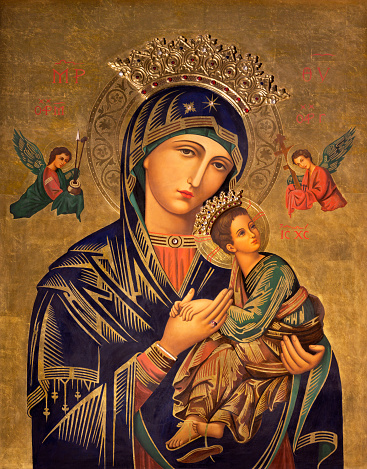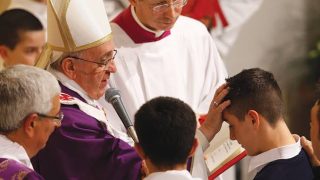
MARY, MODEL OF ALL MOTHERS
HOMILY FOR THE SOLEMNITY OF MARY, MOTHER OF GOD: Readings: Numbers: 6:22-27; Psalm 67; Galatians 4:4-7 and Luke 2:16-21.
The 2012 publication of the Roman Daily Missal gives a beautiful summary of today’s Liturgy. First, we celebrate the first day of the year; then we think of the circumcision of Jesus, that took place eight days after His birth according to Luke 2:21. This day we also remember the pronouncement of the Council of Ephesus as Mary, Mother of God (Theotokos) and finally, in 1968 Pope Paul VI chose January 1st as the World Day of Peace. Today, God is giving us His blessings as a father will bless his children and Peace to hearts that are troubled of what this pregnant year will deliver.
The title of Mary, Mother of God is from the Greek word “Theotokos” which also consists of two Greek words: “Theos” which means “God” and “Tokos” which means “Bearer.” Literally, it is translated to God-bearer or Mother of God. It is a dogma which came as a result of Nestorius heresy that provoked the Third Ecumenical Council in the fifth century, 431 AD with the Decree that Mary is the Mother of God. Nestorius separated the Divine nature of Christ from his Human nature and fell into the heresy. He said that Mary is the Mother of Christ’ human nature, but not the Mother of the Divine nature of Christ. For Nestorius, Mary only birthed the human nature of Christ, not the Divine nature. His heretical formula creates two Jesus Christ while the Church believes in one Jesus Christ. It was Pope Celestine and the Orthodox Bishops that rightfully defended this teaching that Mary bathed the whole person of Jesus Christ. This was done with linguistic and theological/scriptural justification, which has also been contested by many Protestants that the Mother of God is not the correct translation for Theotokos.
In linguistic justification, the Latin text translates this title in two ways: first is “Dei Genitrix,” which means “Birther or genetress of God.” Second is “Mater Dei” which is “Mother of God.” Since we do not commonly refer to our mothers as ‘birther/genetress,’ the Church uses Mother of God, which is more natural. The theological/scriptural justification has its base on Luke 1:43 when Mary visited Elizabeth, being filled with the Holy Spirit she said, “How can the mother of my Lord come to me?” With these, the Council of Ephesus concluded that Mary bathed one single divine person, that is, the second person of the blessed Trinity. If we accept that Jesus Christ is God, it follows therefore that we celebrate the Woman in whose womb God the Son was conceived and so, it is logical to assert that Mary is the Mother of God.
Today’s reading also help us to clarify the Theotokos as it hints essential connection between Mary and God the Son. St. Paul recounts the Incarnation of God in Mary. That is, how God took flesh in the Blessed Virgin Mary. In his letter to Galatians, he tells us that by being born of a woman, born under the law, the Son of God fully participate in the human condition. Through this condition of Christ that we became heirs of Christ, as such, we understand God as Abba/Father. In view of this, that Christ taught us to call God “Our Father” in the Lord’s Prayer, since He is the Son of God and we as Christians have received adoption as sons through Jesus Christ.
The Gospel tells us that Mary fulfilled her role as Mother towards the Son. She conceived and nurtured him with love and tenderness. In Luke’s Gospel, Mary represents the ideal believer, for she hears the good news and ponder it in her heart, and she fully respond to it. Her heart became a place of discovering Jesus. This is how our hearts should be, pondering and responding to Jesus at all times. From the moment of Annunciation, we can’t categorically say Mary completely knew the full significance of her Son. From her fiat/yes, she ponders on what the child will be: She ponders on the Word incarnate, His infancy, His youth, what the child did, the healing, the exorcism, his passion, death, resurrection and ascension. In all, Mary as the Mother of God accompanied God the Sn through every step and stage in life. At each step of the growing child, she re-assert that “Yes” of the Annunciation, she grew knowing the child and comprehending the mystery of the Word incarnate. On this note, she is the model of all mothers.
Today we also celebrate New Year day and world day of peace. As we make our New Year resolutions, may part of our resolution be to ponder this Word (Christ) in our hearts. It is only in Christ that we can find peace. May God bless us this New Year with peace in our hearts, peace in our families, peace in our nation that is full of turbulence and peace in the world at large. The first reading comes with direct blessings from God to us his people. All we need do is to make a resounding amen to these blessings and may these blessings accompany us through this year and beyond through Christ our Lord Amen! Peace be with you!
Happy Solemnity and Happy New Year!
Fr. Ken Dogbo, OSJ










